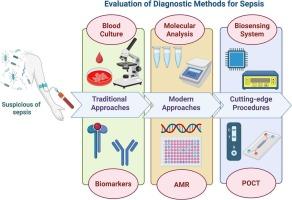Sepsis diagnosis and monitoring: Frontiers in innovative technology
IF 2.9
3区 医学
Q2 MEDICAL LABORATORY TECHNOLOGY
引用次数: 0
Abstract
One of the most common hospital-associated infections, especially in the ICU, is sepsis, and its early detection is a significant issue that health care systems must contend with. Effective treatment of sepsis requires early diagnosis and rapid therapeutic intervention. The early detection of this life-threatening condition is significantly improved not only by identifying drug-resistant pathogens but also by detecting unique immune response biomarkers that arise upon pathogen invasion, thus creating a critical early warning system. The methodology involves advanced molecular diagnostic tools, such as real-time PCR, MALDI-TOF mass spectrometry, and novel biomarker detection platforms. These methods enable faster identification of pathogens and biomarkers, enhancing the accuracy and speed of sepsis diagnosis. We also discuss the integration of these technologies with clinical workflows, considering their impact on patient outcomes and healthcare efficiency. In this paper, we review novel and rapid sepsis diagnostic techniques compared to traditional methods, emphasizing the significance and efficiency of the emerging technologies. An extensive review of the literature was conducted through databases such as PubMed, Scopus, Web of Science, and Google Scholar with keywords such as “sepsis” and “diagnostic strategies” to identify the most suitable articles for this review. Effective management of sepsis, a complex and deadly disease, relies on knowledge and application of rapid diagnostic techniques, such as new analytic tools, for successful treatment and improved patient outcomes. Advanced molecular diagnosis and clinical trials are maximizing therapeutic control with biomarker tracking (sTREM-1, IL-6, PCT) and improving diagnostic accuracy. Introducing new technologies in molecular diagnosis, analysis, and clinical management is crucial to improve septic shock patient outcomes. Our review highlights that while traditional methods such as blood culture remain essential, they are limited by long turnaround times and reduced sensitivity. Rapid molecular assays (PCR, MALDI-TOF) and biosensor-based point-of-care platforms provide results within hours, enabling earlier targeted treatment. Among biomarkers, procalcitonin remains the most established, but newer candidates such as presepsin, CXCL5, and circRNAs show promising diagnostic and prognostic potential. Integrating these innovative technologies into clinical workflows can enhance early detection, support antimicrobial stewardship, and ultimately improve patient survival.

败血症诊断和监测:创新技术的前沿。
脓毒症是最常见的医院相关感染之一,特别是在ICU,其早期检测是卫生保健系统必须解决的一个重要问题。脓毒症的有效治疗需要早期诊断和快速治疗干预。这种危及生命的疾病的早期检测不仅可以通过识别耐药病原体,还可以通过检测病原体入侵时产生的独特免疫反应生物标志物,从而创建一个关键的早期预警系统。该方法涉及先进的分子诊断工具,如实时PCR, MALDI-TOF质谱,以及新的生物标志物检测平台。这些方法能够更快地识别病原体和生物标志物,提高败血症诊断的准确性和速度。我们还讨论了这些技术与临床工作流程的集成,考虑到它们对患者结果和医疗效率的影响。在本文中,我们回顾了新的和快速的脓毒症诊断技术与传统方法的比较,强调了新兴技术的意义和效率。通过PubMed、Scopus、Web of Science和谷歌Scholar等数据库对文献进行了广泛的综述,关键词为“败血症”和“诊断策略”,以确定最适合本综述的文章。脓毒症是一种复杂而致命的疾病,有效的管理依赖于快速诊断技术的知识和应用,如新的分析工具,以成功治疗和改善患者的预后。先进的分子诊断和临床试验正在通过生物标志物跟踪(sTREM-1, IL-6, PCT)最大限度地提高治疗控制,并提高诊断准确性。引入分子诊断、分析和临床管理的新技术对于改善脓毒性休克患者的预后至关重要。我们的综述强调,虽然血培养等传统方法仍然必不可少,但它们受到周转时间长和灵敏度降低的限制。快速分子检测(PCR、MALDI-TOF)和基于生物传感器的护理点平台可在数小时内提供结果,从而实现更早的靶向治疗。在生物标志物中,降钙素原仍然是最成熟的,但较新的候选物如pressepsin, CXCL5和circrna显示出有希望的诊断和预后潜力。将这些创新技术整合到临床工作流程中可以加强早期检测,支持抗菌药物管理,并最终提高患者存活率。
本文章由计算机程序翻译,如有差异,请以英文原文为准。
求助全文
约1分钟内获得全文
求助全文
来源期刊

Clinica Chimica Acta
医学-医学实验技术
CiteScore
10.10
自引率
2.00%
发文量
1268
审稿时长
23 days
期刊介绍:
The Official Journal of the International Federation of Clinical Chemistry and Laboratory Medicine (IFCC)
Clinica Chimica Acta is a high-quality journal which publishes original Research Communications in the field of clinical chemistry and laboratory medicine, defined as the diagnostic application of chemistry, biochemistry, immunochemistry, biochemical aspects of hematology, toxicology, and molecular biology to the study of human disease in body fluids and cells.
The objective of the journal is to publish novel information leading to a better understanding of biological mechanisms of human diseases, their prevention, diagnosis, and patient management. Reports of an applied clinical character are also welcome. Papers concerned with normal metabolic processes or with constituents of normal cells or body fluids, such as reports of experimental or clinical studies in animals, are only considered when they are clearly and directly relevant to human disease. Evaluation of commercial products have a low priority for publication, unless they are novel or represent a technological breakthrough. Studies dealing with effects of drugs and natural products and studies dealing with the redox status in various diseases are not within the journal''s scope. Development and evaluation of novel analytical methodologies where applicable to diagnostic clinical chemistry and laboratory medicine, including point-of-care testing, and topics on laboratory management and informatics will also be considered. Studies focused on emerging diagnostic technologies and (big) data analysis procedures including digitalization, mobile Health, and artificial Intelligence applied to Laboratory Medicine are also of interest.
 求助内容:
求助内容: 应助结果提醒方式:
应助结果提醒方式:


